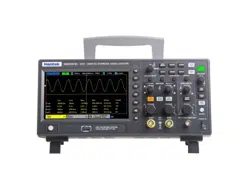Loading ...
Loading ...
Loading ...

User Manual
27 / 68
both rising and falling edge.
⚫ If the upper trigger level is within the waveform amplitude range while the lower trigger level is out of the waveform
amplitude range, the oscilloscope will trigger on rising edge only.
⚫ If the lower trigger level is within the waveform amplitude range while the upper trigger level is out of the waveform
amplitude range, the oscilloscope will trigger on falling edge only.
1. Press the [Trig Menu] button on the front panel to enter the Trigger function menu.
2. Press the Type softkey, then use the Multifunctional Knob to select Window and push down the knob to confirm.
3. Press the Source softkey, turn the Multifunctional Knob to select CH1~CH2 as the trigger source.
4. Press Level softkey to select Lower or Upper trigger level or both levels, then turn the Trigger Level Knob to adjust the
position. The trigger level values are displayed at the upper right corner of the screen. The trigger different level value between
Upper and Lower is displayed at the upper right corner of the screen.
The Lower trigger level cannot be upper than the upper trigger level. V1 means the upper trigger level while V2 means the
lower trigger level.
5. Press the Mode softkey, turn V0 to select the trigger mode (auto, normal), and press V0 to confirm.
Auto: When the oscilloscope meets the trigger condition, it completes a trigger acquisition once; when the trigger condition is
not met, it can run the acquisition waveform freely.
Normal: When the oscilloscope meets the trigger condition, the input waveform is displayed; when the trigger condition is not
met, the original waveform is displayed.
6. Press the Holdoff softkey and turn V0 to set the time that the oscilloscope waits before a trigger to the next trigger, so that
complex waveforms are displayed stably.
2.7.7. Pattern Trigger
Identify a trigger condition by looking for a specified pattern. This pattern is a logical "AND" or “Or” combination of channels.
Each channel can have a value of high (1), low (0) or don't care (X). A rising, falling edge, rising or falling can be specified for
one channel included in the pattern. When an edge is specified, the oscilloscope will trigger at the edge specified if the pattern
set for the other channels are true (namely the actual pattern of the channel is the same with the preset pattern). If no edge is
specified, the oscilloscope will trigger on the last edge that makes the pattern true. If all the channels in the pattern are set to
"Don’t Care", the oscilloscope will not trigger.
To set interval trigger:
Loading ...
Loading ...
Loading ...
